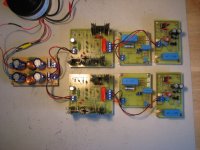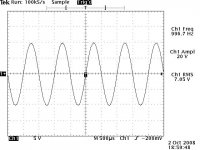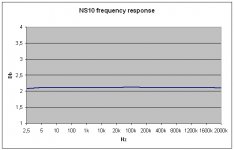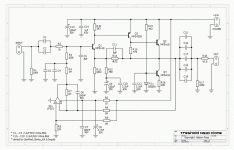One more picture. This is the whole family.
The small board in the middle is the B1 buffer. We deleted the CRC supply, to make it run from the Toole reg. It sounds superb, running from the new supply. The plan is to build both the B1 and the NS10 into the same case and make it switchable between gainstage and buffer for flexibility in use.
🙂
The small board in the middle is the B1 buffer. We deleted the CRC supply, to make it run from the Toole reg. It sounds superb, running from the new supply. The plan is to build both the B1 and the NS10 into the same case and make it switchable between gainstage and buffer for flexibility in use.
🙂
Attachments
mighty Steen
me likey 😉
is it coincidence ...... or proof of your words , about eternal freshness of
dreky NS10 .......
lookie lookie :
me likey 😉
is it coincidence ...... or proof of your words , about eternal freshness of
dreky NS10 .......

lookie lookie :
Re: mighty Steen
Could be both, maybe😉
Great to hear you like it, and the Shiny/NS10 you point to is very nice. How does the young builder think of the sound?
🙂
BTW, mind you, that the plot I posted of the response is not trying to hide anything, as the average responses you see on commercial gear. This is the raw deal, and how every response curve should be made😉 In fact, the plot is exagerating somewhat.
Zen Mod said:
is it coincidence ...... or proof of your words , about eternal freshness of
dreky NS10 .......
lookie lookie :
Could be both, maybe😉
Great to hear you like it, and the Shiny/NS10 you point to is very nice. How does the young builder think of the sound?
🙂
BTW, mind you, that the plot I posted of the response is not trying to hide anything, as the average responses you see on commercial gear. This is the raw deal, and how every response curve should be made😉 In fact, the plot is exagerating somewhat.
HA-HA, "young bilder" with gray beard... Ya killin me... 😀
Anyway, my slightly overkill version of Shiny (squeezed in 2x10.000uF instead of 2x2200uF) per Shiny per channel, is what I was looking for to be able to give some proper kick into F5's lazy butt. Now my ESLs are finaly able to show what they are capable of, and I'm afraid that many will hate this sort of combination. I already know one guy who came and brought his own two Miles CDs, had a few tracks by request and commented : "What a shittey recordings I have, I never knew this before"
For those with cheaper tickets: Absolutely capable of revealing everything. Might make you go back to some commercial stuff. Fortunately, had a fair time spent on Fostex horns and got used to enjoy music, not listen to sounds... 😎
Anyway, my slightly overkill version of Shiny (squeezed in 2x10.000uF instead of 2x2200uF) per Shiny per channel, is what I was looking for to be able to give some proper kick into F5's lazy butt. Now my ESLs are finaly able to show what they are capable of, and I'm afraid that many will hate this sort of combination. I already know one guy who came and brought his own two Miles CDs, had a few tracks by request and commented : "What a shittey recordings I have, I never knew this before"
For those with cheaper tickets: Absolutely capable of revealing everything. Might make you go back to some commercial stuff. Fortunately, had a fair time spent on Fostex horns and got used to enjoy music, not listen to sounds... 😎
stein2 said:........ got used to enjoy music, not listen to sounds... 😎
I will/would/should take you for that ......

Steen has been very modest explaining all the effort he did building this outstanding set of lineamps which included setup and testing of the Toole suntreg, congrats for this Steen.
We have to thanks also Colin Toole for his support and tips on setting this regulator starting from his topology shown else where on the solid state forum.
Actually the response of the NS10 would have looked like a ruler flat line if he had plot it on a dB scale besides he did have a 5pf low pass cap at the input which starts to show at around 1MHz. A 10pf there might get rid of the very shallow bump at 100KHz. All in all an excellent NS10 Clone with a huge band width which will put to shame many commercial offerings.
On the other hand the shunt reg it’s a dandy, easy to build, low in cost, no tendency for instability, all discrete, no feedback and ruler flat impedance up to the MHz region. Besides, as far as we know this reg can be easily adjusted from 15 up to 30V maybe more, so a good project to test for anyone. Ohhh, forgot to mention the reg can be setup for positive or negative supply using the same PCB.
We have to thanks also Colin Toole for his support and tips on setting this regulator starting from his topology shown else where on the solid state forum.
Actually the response of the NS10 would have looked like a ruler flat line if he had plot it on a dB scale besides he did have a 5pf low pass cap at the input which starts to show at around 1MHz. A 10pf there might get rid of the very shallow bump at 100KHz. All in all an excellent NS10 Clone with a huge band width which will put to shame many commercial offerings.
On the other hand the shunt reg it’s a dandy, easy to build, low in cost, no tendency for instability, all discrete, no feedback and ruler flat impedance up to the MHz region. Besides, as far as we know this reg can be easily adjusted from 15 up to 30V maybe more, so a good project to test for anyone. Ohhh, forgot to mention the reg can be setup for positive or negative supply using the same PCB.
stein2 said:HA-HA, "young bilder" with gray beard... Ya killin me... 😀
😎
There you go, Choky got me there😀 Typical....
As you say it is revealing, and to my ears still very good sounding. The wide flat bandwith, does result in a very detailed sounding preamp. Did you make any measurements? The version we build, starts clipping at approx 1,3V input but is at that point doing just under 8V RMS out and over 20V PP. It's a strong little fellow. Attached is a sinewave at 1,2V input.
Thanks Tony, and thanks for the suggestion about the LPF cap.
I will try and install some 10pF caps at the input, and see what that brings. Allthough I would say that the bandwidth is huge and flat as a dancefloor, from 7Hz to 2 MHz. The Y-axis tells the truth, one can bring out a ruler and take a few readings😉 Setting the Y-axis intervals as I did, makes it easier to see the deviations but it will also confuse someone.
I am also using a Toolereg right now with a D1 I/V , running at +/-30V, with very good result. The reg is totally free from any sort of noise/hum, even at this level of signal processing.
Anyone with a B1 buffer should really try it with this regulator. It is simply a superb combination and nearly electrostatic in transparency.
🙂
Attachments
steenoe said:
There you go, Choky got me there😀 Typical....
As you say it is revealing, and to my ears still very good sounding. The wide flat bandwith, does result in a very detailed sounding preamp. Did you make any measurements?
I never bothered with measurements. ... Choky told me that NS10+Shiny is what I want to use with the F5. Ok, then, I'll build it.
And I did, and he was right and it is what I had to use between my CD and F5 to get enough gain for older recordings.
I can tolerate a certain amount of distortion, as long as it doesn't collide with music (tubeamps often do that) and 0,1 or 0,00001 does not make a difference, I pick the better by listening to it.
This time I was lucky to build it and not regret it

That's a nice plot Steen and shows how good this preamp is, BW shoots through the roof.
BTW, here is the last schematic we have on a pdf file which is more handy. As far as I know Steen didn't use any of the optional components shown on his circuit so it's a very close to original NS10 clone.
BTW, here is the last schematic we have on a pdf file which is more handy. As far as I know Steen didn't use any of the optional components shown on his circuit so it's a very close to original NS10 clone.
Attachments
As we are here, here's how my NS10 clone was built, with note on N trannies I used BC550C and for P BC560C. IC is TL071... The supply is a bit higher at 27VDC but only because I was too lazy to fiddle with the number and colors of LEDs to get it down to exactly 24Volts.
Attachments
apassgear said:Stein,
Did you actually use the FB cap marked as C11?
Yup, except mine is (well, "are") measured to exactly 5.1pF to have a matched pair, spent ten minutes picking them in the shop. Why do you ask?
(uh-uh, BTW, also have a 6dB 10.4nF HP filter for the secondary output for the ESLs and from the main output the signal goes to the sub amp...)
Just asked because Steen seems to have detected some sort of problem when using C11, he might chip in later and see what those were.
apassgear said:Just asked because Steen seems to have detected some sort of problem when using C11, he might chip in later and see what those were.
I had a small, now sorted issue in the first initial test. The pot was not grounded and the signal mass was directly grounded to the mains ground. During signal volume adjustments, the sound would disappear (go mute) and some sort of very high frequency (oscillation) would appear instead. As soon as I replaced the plain wiring with coax and grounded the signal mass through a thermistor, no further odd behavior. At least not in form of heating or audible/visible things...
Implementing C11, introduced some hissing noise, but since the wiring in the test-setup was all messy ( and unshielded) I didnt investigate the matter. The volume pot was also a bit touchy. The NS10 clone is being build into its case right now with prober wiring and grounding scheme. I will investigate things when everything is build as it should be. It is probably better to trim the final details under real life conditions, and not with a messy pile of boards and wires lying on a piece of chipboard. It would be great to see that little bump at 100kHz trimmed down to level with the average signal strength. If we can do that, the preamp can be used for calibrating measuring instruments je-je-je 😉
Stein, do you have 2 parallel outputs, with a HP filter on one of them? If yes, how did you isolate the HP circuit from the main OP?
(Sounds like an interesting idea)
🙂
Stein, do you have 2 parallel outputs, with a HP filter on one of them? If yes, how did you isolate the HP circuit from the main OP?
(Sounds like an interesting idea)
🙂
steenoe said:
Stein, do you have 2 parallel outputs, with a HP filter on one of them? If yes, how did you isolate the HP circuit from the main OP?
(Sounds like an interesting idea)
🙂
I have the F5 for the electrostatic panels which really work great together, but not with FR input. Had to cut the LF off the F5 input and the rough combination with the 100k Zin came to around 10nF. I thought that the simplest way would be to go in parallel with the output cap which has to be big enough because it goes to the sub-amp. So, according to the schematic I attached, the signal is taken from the joint of Q3E-Q4C-R9 (etc)... In a nutshell, parallel, except I used no additional resistors after the 10nF cap. In F5 there's a series 1K after that 10nF and the 100K parallel to signal ground. Can you do a quickie approximation where do I cut the high pass?
stein2 said:
Can you do a quickie approximation where do I cut the high pass?
Thats 160hZ. Probably a good place to cut.
f= (1:2x3.14)x1000, where 1000 is the timeconstant (R=100000xC=0.01= 1000).
BTW, that is a pretty smart approach for adding a subwoofer.
What electrostatic's are you using?
🙂
steenoe said:
Thats 160hZ. Probably a good place to cut.
f= (1:2x3.14)x1000, where 1000 is the timeconstant (R=100000xC=0.01= 1000).
BTW, that is a pretty smart approach for adding a subwoofer.
What electrostatic's are you using?
🙂
😀
The panels are made locally by a guy named Zoltan and from that comes "Soltanus Audio" which seems to be the name he intends to use in the future for his products. I had a chance to see and hear his very first panels some ten years ago when he just started. He evolved to the point where 1000€ for a pair of panels is an investment (by my modest opinion) worth every cent. He also builds an odd hybrid amp based on Quad405 replica and a SRPP tube stage but lately he developed his own design that takes it's roots from there, but goes in a different direction. Anyway, all matter of taste, and even though it made me sell all the other factory built amps and build the F5 and the NS10, I have no regrets. Never had it so good before... 😉 Anyway, the panels have a nice, very linear response from around 110Hz and really appreciate the 6dB cut at that 160Hz... The sub has an adjustable 40-180Hz cut which makes it quite easy to get the proper setup.
On the other hand the shunt reg it’s a dandy, easy to build, low in cost, no tendency for instability, all discrete, no feedback and ruler flat impedance up to the MHz region. Besides, as far as we know this reg can be easily adjusted from 15 up to 30V maybe more, so a good project to test for anyone.
Steen/apassgear: could it be possible to have a schematic of the final setup of TooleReg (and the PCB, also 😉 )? I'm currently playing on master
 ZenMod's Shiny👍, and the TooleReg is an interesting alternative.
ZenMod's Shiny👍, and the TooleReg is an interesting alternative.Thanks
- Status
- Not open for further replies.
- Home
- Amplifiers
- Pass Labs
- Threshold NS10 Lineamp PCB



